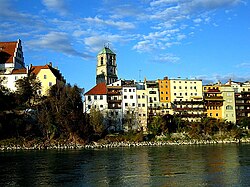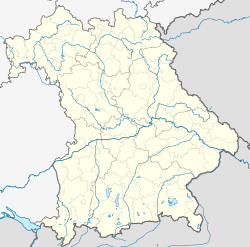world.wikisort.org - Germany
Wasserburg am Inn (Central Bavarian: Wassabuag am Inn) is a town in Rosenheim district in Upper Bavaria, Germany. The historic centre is a peninsula formed by the meandering river Inn. Many Medieval structures remain intact, giving the city a unique view.
Wasserburg am Inn | |
|---|---|
Town | |
 Wasserburg am Inn | |
 Coat of arms | |
Location of Wasserburg am Inn within Rosenheim district  | |
 Wasserburg am Inn  Wasserburg am Inn | |
| Coordinates: 48°03.7′N 12°14.0′E | |
| Country | Germany |
| State | Bavaria |
| Admin. region | Oberbayern |
| District | Rosenheim |
| Government | |
| • Mayor (2020–26) | Michael Kölbl[1] (SPD) |
| Area | |
| • Total | 18.80 km2 (7.26 sq mi) |
| Elevation | 427 m (1,401 ft) |
| Population (2020-12-31)[2] | |
| • Total | 12,662 |
| • Density | 670/km2 (1,700/sq mi) |
| Time zone | UTC+01:00 (CET) |
| • Summer (DST) | UTC+02:00 (CEST) |
| Postal codes | 83512 |
| Dialling codes | 08071 |
| Vehicle registration | RO, AIB, WS |
| Website | www.wasserburg.de |

History

The town was first mentioned in a document (now considered to be a fake) in 1137, when Hallgraf Engelbert moved his residence from the nearby castle Limburg to his "Wasserburg" (Water Castle). It is one of the most historic towns of Old Bavaria – somewhat older than Munich, continually fought over by the Bavarian nobility and, up to the 16th century, on an equal footing with larger cities. The privileges afforded by this enabled the salt trade to flourish right into the 19th century. At the junction of the main overland route with the main water route, Wasserburg became the most important trade centre with the Balkans, Austria and Italy, a means of attaining power and wealth for the shipping owners and merchants.
In the early days, Wasserburg was an important hub in the salt trade. Its bridge was the only possibility to cross the river Inn for 30 km in both directions. On its shore the salt, mined in Berchtesgaden or produced in the Saline (saltern) at Bad Reichenhall and shipped from there by cart, could be loaded on ships travelling on the Inn River. Up to the 17th century Wasserburg was used as the port of the capital Munich.
Up until 1972, when it was merged with the district Rosenheim, Wasserburg was a district capital on its own.
The population of Wasserburg is approx. 12,000.
In literature
Gustav Meyrink's most esoteric novel The White Dominican (German: Der weiße Dominikaner) is set in a mystical version of the town of Wasserburg.
References
- Liste der ersten Bürgermeister/Oberbürgermeister in kreisangehörigen Gemeinden, Bayerisches Landesamt für Statistik, 15 July 2021.
- "Tabellenblatt "Daten 2", Statistischer Bericht A1200C 202041 Einwohnerzahlen der Gemeinden, Kreise und Regierungsbezirke". Bayerisches Landesamt für Statistik (in German). June 2021.
External links
![]() Media related to Wasserburg am Inn at Wikimedia Commons
Media related to Wasserburg am Inn at Wikimedia Commons
На других языках
[de] Wasserburg am Inn
Wasserburg am Inn (amtlich Wasserburg a.Inn) ist eine Stadt im oberbayerischen Landkreis Rosenheim. Sie liegt etwa 55 km östlich der Landeshauptstadt München und etwa 25 km nördlich der Kreisstadt Rosenheim. Sie war Sitz des Landgerichts Wasserburg a.Inn, aus dem das Amtsgericht Wasserburg am Inn sowie das Bezirksamt, das spätere Landratsamt Wasserburg a.Inn, hervorgingen.- [en] Wasserburg am Inn
[ru] Вассербург-ам-Инн
Ва́ссербург-ам-Инн[2][3], Ва́ссербург[3] (нем. Wasserburg am Inn) — город в Верхней Баварии (Oberbayern) на реке Инн (отсюда название). Расположен в 55 км к востоку от Мюнхена. Входит в состав района Розенхайм.Другой контент может иметь иную лицензию. Перед использованием материалов сайта WikiSort.org внимательно изучите правила лицензирования конкретных элементов наполнения сайта.
WikiSort.org - проект по пересортировке и дополнению контента Википедии